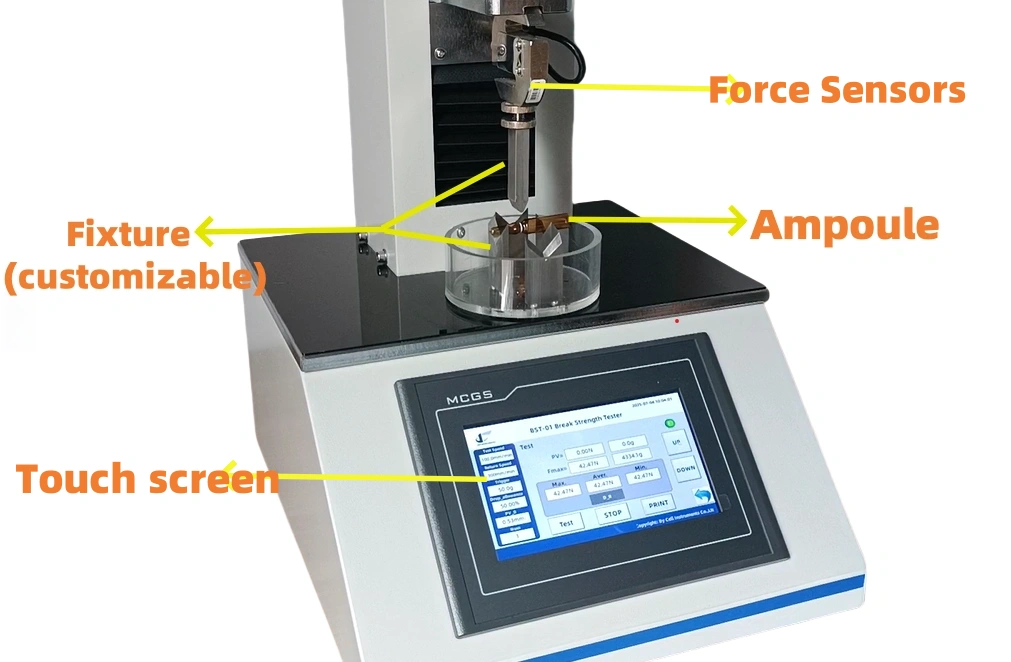ISO 9187 Compliance and Breaking Force Measurement for Glass Ampoules
Introduction to ISO 9187-1 for Ampoules
ISO 9187 is a critical international standard that specifies the technical and performance requirements for glass ampoules used in medical injectables. The standard ensures that ampoules are safe, reliable, and suitable for containing sterile pharmaceutical products. It primarily applies to ampoules made of glass and focuses on key properties such as hydrolytic resistance, annealing quality, and the breaking force required to open the ampoule cleanly and safely.
In medical and pharmaceutical settings, ampoules must maintain sterility while being easy to open without causing glass shards or user injury. Hence, accurate breaking force measurement for glass ampoules is essential, and ISO 9187-1 provides the precise test protocols to assess this property.
Breaking Force Measurement for Glass Ampoules and the Role of ISO 9187-1
The ampoule breaking test ISO 9187-1 defines a standardized method for determining the breaking force of ampoules. This ensures that they break predictably at a predetermined point, typically marked by a ceramic ring or colored pigment.
According to ISO 9187-1:2010, the breaking force test must be conducted using a tensile testing machine compliant with ISO 7500-1. Key apparatus specifications include:
- Test speed: 10 mm/min
- Force measuring range: 200 N
- Sample conditioning: 20 ± 5 °C
- Sampling plan: Random, per ISO 2859-1, Level S-4
The ampoule is positioned with force applied perpendicularly at the break point. A clean break with a force within specified limits (per Table 2 of the standard) is required for compliance. Deviations in angle or position may drastically increase the breaking force, indicating improper ampoule design or manufacturing.
Core Testing Requirements Under ISO 9187-1
To ensure ampoules are both user-safe and manufacturing-compliant, ISO 9187-1 sets the following benchmarks:
- Hydrolytic Resistance
Must conform to ISO 4802-1 and ISO 4802-2, ensuring glass does not deteriorate on exposure to water or sterilization. - Annealing Quality
Residual stress after annealing must not exceed 50 nm per millimeter of glass thickness. Improper annealing can lead to micro-cracks or sudden fracture. - Breaking Force
Measured under controlled mechanical conditions. The break should occur cleanly at the designed point with minimal residue and no glass fragmentation. - Position and Stability of Breaking Point (per ISO 9187-2)
The break point must be centrally aligned (±1 mm deviation) and withstand sterilization, cleaning, and thermal shock without displacement or degradation.
Why Accurate Breaking Force Testing Matters
Accurate breaking force measurement for glass ampoules is vital to maintain patient safety, product integrity, and regulatory compliance. An ampoule that breaks unpredictably can lead to:
- Contamination of the injectable product
- Injury to healthcare professionals
- Rejection of entire production batches
- Non-compliance with international quality audits
Recommended Solution: BST-01 Ampoule Breaking Tester by Cell Instruments
For pharmaceutical manufacturers, quality control labs, and regulatory inspection bodies seeking reliable compliance with ISO 9187, the BST-01 Ampoule Breaking Tester by Cell Instruments offers a robust, high-precision solution. This advanced system:
- Fully complies with ISO 9187-1 breaking force test methodology
- Provides accurate force measurements with high repeatability
- Supports programmable test parameters and automated data recording
- Features easy sample loading and alignment to minimize operator error
By integrating the BST-01 into your QC workflow, you ensure every ampoule meets international safety and quality standards.
Conclusion: Ensuring Compliance and Safety through ISO 9187-1 Testing
Adhering to ISO 9187-1 is not just about meeting regulatory requirements—it’s about protecting patient safety and brand integrity. With precise ampoule breaking test ISO 9187-1 procedures, manufacturers can guarantee consistent product quality. The BST-01 Ampoule Breaking Tester from Cell Instruments provides the assurance and technical capability needed for accurate, efficient compliance testing.
To stay ahead in pharmaceutical quality control, choosing the right instrumentation—and understanding standards like ISO 9187—is essential.

